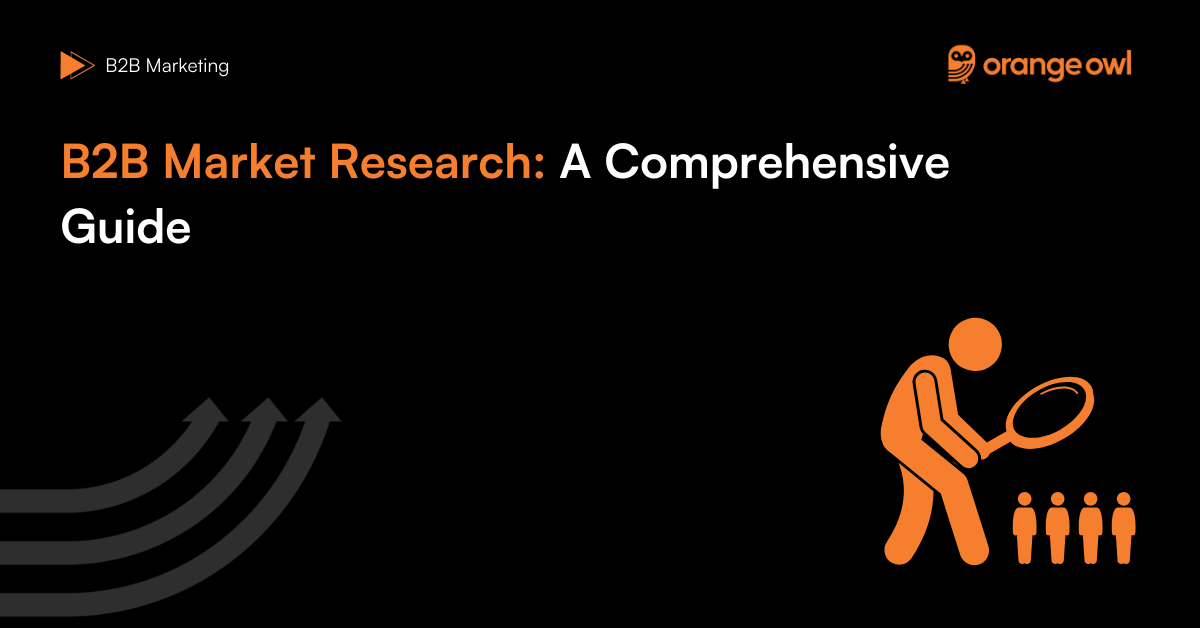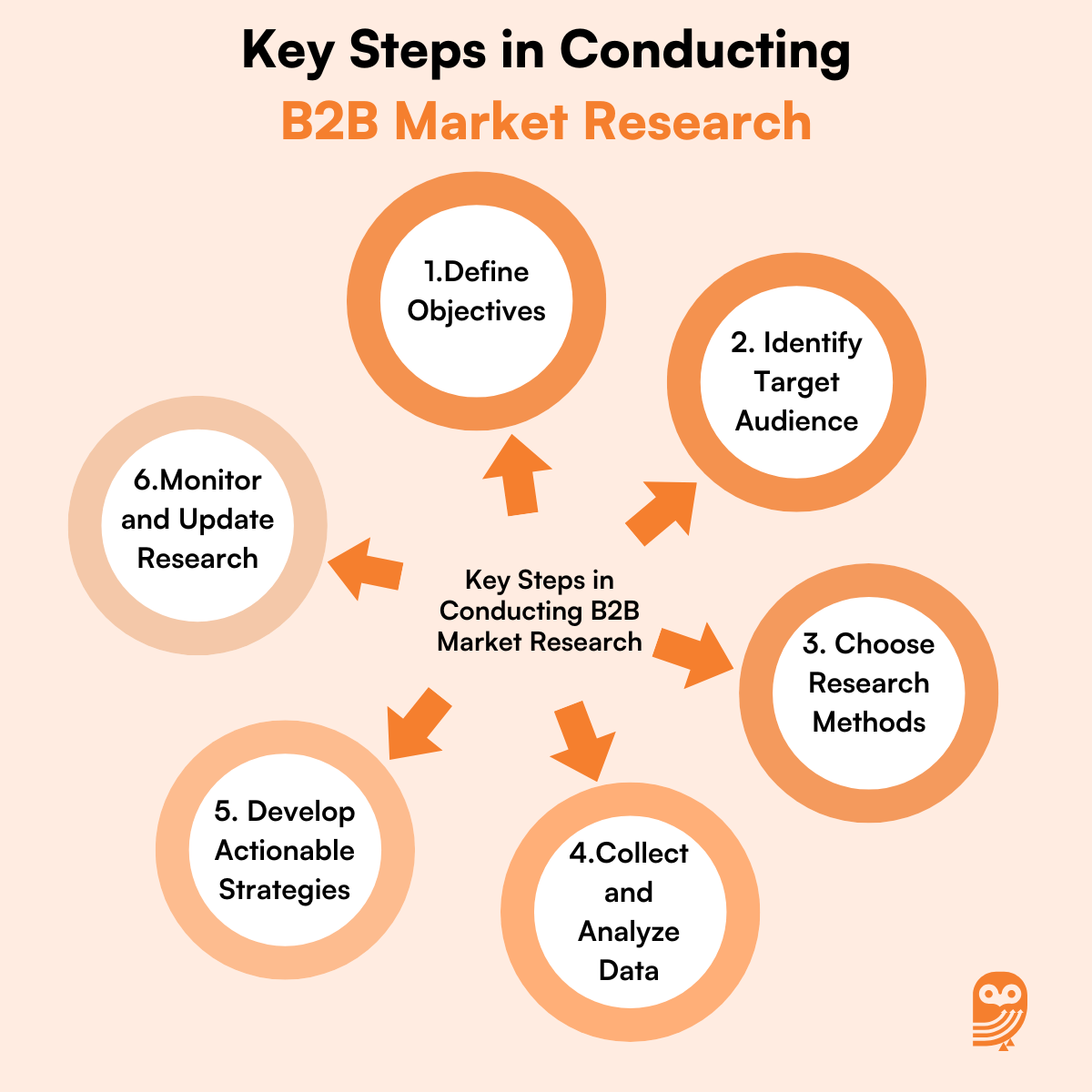B2B Market Research: A Comprehensive Guide
Vivek Goel
March 17, 2025

Table of Contents
Introduction
Market research is the backbone of any successful B2B marketing strategy. Unlike B2C marketing, where individual consumer preferences drive sales, B2B marketing involves complex decision-making processes, multiple stakeholders, and longer sales cycles.
According to a study by HubSpot, 81% of businesses conduct market research to gain a competitive advantage. Effective market research helps companies to understand their target audience, analyze competitors, and create strategies that align with market needs. This blog delves into the importance, methods, and best practices for conducting market research in B2B marketing.
What is B2B Market Research?
B2B market research gathers data on what potential customers are looking for and what they need. The research can cover everything from brand perception, product fit, customer service requirements, sales and marketing strategies, and more.
It involves taking a sample of your target audience and understanding their motivations and preferences. By researching how your potential audience thinks, feels, and behaves, your strategic planning for attracting your target market will be more effective.
Also, when you have them on board, you won’t risk creating an experience gap where your customers aren’t getting what they expect. You’ll be better able to predict future trends and tackle issues before they happen, ensuring your business remains competitive and relevant.
Why Do Businesses Conduct B2B Marketing Research?
B2B organizations conduct market research to achieve various business objectives, ensuring they remain competitive, relevant, and customer-centric.
1. Building Market Segmentation
Market research helps businesses develop detailed buyer personas, define customer or market segments, and create competitor/marketplace maps. By segmenting the market based on industry, company size, geographic location, and behavioral patterns, businesses can ensure precise targeting, optimize marketing resources, and craft personalized campaigns that yield higher engagement rates.
Example: A cloud-based SaaS company identifies three main customer segments—small businesses looking for affordable solutions, mid-sized enterprises needing scalability, and large corporations requiring advanced security features. This segmentation helps the company design tiered pricing plans tailored to each group’s needs.
2. Understanding the Buying Process
B2B buyers are professionals with specific needs and responsibilities. Research helps in identifying their pain points, preferences, and decision-making processes by analyzing decision-makers and influencers, interpersonal dynamics, and key purchasing factors like price, trust, and service quality.
Example: A cybersecurity firm finds that IT managers conduct initial research, but CTOs make the final purchasing decision. This insight helps the firm create targeted content—technical whitepapers for IT managers and cost-benefit analyses for CTOs.
3. Developing Brand Strategy
Market research enables businesses to gauge brand perceptions, differentiate from competitors, and identify factors driving customer loyalty. It also allows testing of new messaging, determination of the most effective communication channels, and optimization of brand architecture for a stronger market presence.
Example: A B2B fintech startup conducts research and finds that potential clients view them as an innovative but risky option. To address this, they showcase case studies and testimonials from established customers, improving trust and credibility.
4. Tracking Business Perceptions
Measuring brand equity (awareness, consideration), customer satisfaction, and loyalty ensures businesses maintain a strong market position. Monitoring performance through tools like Net Promoter Score (NPS) and customer feedback surveys helps fine-tune offerings, build long-term relationships, and identify which products or services customers value most.
Example: A logistics company tracks its NPS and realizes customers find its tracking system outdated. By upgrading to real-time tracking and communicating the change through marketing, customer satisfaction improves significantly.
5. Competitive Analysis
Understanding competitors’ strengths, weaknesses, pricing models, and marketing tactics allows businesses to position themselves effectively. Research helps uncover gaps in the market, develop unique value propositions, and refine strategies to outperform competitors.
Example: A CRM software provider discovers that competitors lack strong integration with third-party tools. By emphasizing its seamless integrations in marketing efforts, it attracts more customers looking for flexibility.
6. Product and Service Development
Research helps businesses generate new ideas, test product and service concepts, optimize pricing strategies, and develop go-to-market strategies. It also aids in forecasting market trends and future demands, ensuring products and services align with customer needs.
Example: A B2B e-commerce platform surveys users and finds demand for AI-powered product recommendations. After implementing this feature, the platform sees increased user engagement and sales.
7. Identifying Emerging Trends & Risk Mitigation
Staying ahead in B2B markets requires tracking key industry concerns, trends, and challenges. Research helps businesses anticipate risks such as market fluctuations, regulatory changes, and industry disruptions, allowing proactive strategy adjustments to mitigate potential threats.
Example: A manufacturing company tracks global raw material shortages and switches to alternative suppliers before competitors, ensuring uninterrupted production.
8. Enhancing Customer Experience
Customer feedback loops, satisfaction surveys, and real-time analytics help businesses refine their offerings. Research provides insights into expectations, improving products, services, and overall customer satisfaction while fostering long-term client relationships.
Example: A software development company collects feedback and discovers users struggle with onboarding. They introduce a step-by-step tutorial, reducing customer support requests and improving user experience.
9. Developing Content & Thought Leadership
B2B businesses leverage research to craft content strategies, identify key topics that engage their audience, create data-driven thought leadership reports, and refine messaging to better resonate with their target market. This strengthens brand credibility and positions businesses as industry leaders.
Example: A marketing automation firm conducts a study on email marketing trends and publishes a report that gains significant media coverage, positioning the brand as a thought leader.
10. Prioritizing Research Efforts
Given limited budgets and resources, businesses must prioritize research projects such as:
- Understanding Customer Segments – Going beyond firmographics to analyze motivations, behaviors, and needs for targeted marketing strategies.
Example: A cybersecurity firm segments its audience based on security concerns—some prioritize compliance, others focus on preventing cyberattacks. Marketing messages are then tailored accordingly. - Monitoring Performance – Measuring customer satisfaction and loyalty to refine offerings continuously.
Example: An enterprise software company tracks customer churn and finds pricing concerns are a major reason, prompting a more flexible payment model. - Tracking Trends – Identifying shifts in customer preferences and market conditions to stay ahead of competitors.
Example: A B2B consulting firm monitors industry trends and launches a new service based on the growing demand for AI-driven analytics.
By conducting comprehensive B2B market research, businesses gain valuable insights that drive strategic decision-making, improve competitiveness, and foster sustainable growth.
Differences Between B2B and B2C Market Research
There are fundamental differences between B2B market research and B2C market research that affect how businesses approach data collection and analysis.
- Complex and Niche Markets – B2B research often focuses on more specialized markets than B2C. Enterprise and large businesses have very focused or complicated audiences, whereas B2C markets may be broader and more straightforward.
- Longer Decision-Making Cycles – B2B customers typically take longer to purchase due to multiple stakeholders being involved. This makes it crucial to conduct in-depth research on their decision-making process.
- Higher Stakes and Larger Purchases – B2B buyers often deal in large-scale transactions unlike individual consumers. Understanding how these companies allocate their budgets and make purchasing decisions is vital.
- Need for Competitive Differentiation – Since B2B customer pools are often smaller, businesses must clearly understand how they compare to competitors. Market research provides insights into customer perceptions, enabling companies to refine their value propositions and stand out.
Benefits of Conducting B2B Market Research
- Maximizing ROI – With business research behind you, you can more effectively target customers and encourage engagement with your brand. The more tailored your offering is to what they want, the more they’ll spend with you, leading to higher revenue generation.
- Keeping Up with Industry Trends – Customer needs and market trends constantly evolve. B2B market research allows businesses to stay ahead of industry changes and adjust their strategies accordingly.
- Attracting High-Value Clients – If you’re looking to target enterprise clients and industry leaders, you’ll need market research to understand your competitive advantage—or what you need to do to gain one.
- Performance Monitoring – Asking potential or current customers how you’re doing regularly allows you to tailor your approach to meet their expectations. Rather than guessing, you’ll have data-backed proof of your success (or areas that need improvement).
Methods of Conducting B2B Market Research
1. Primary Research
Primary research involves collecting firsthand data directly from sources through various methods:
- Surveys and Questionnaires – Businesses can gather insights from potential clients, industry experts, and stakeholders about their needs, preferences, and challenges. Surveys can be distributed through email campaigns, LinkedIn polls, or company websites to gather quantitative data.
- Interviews – One-on-one interviews with industry leaders, existing clients, or potential customers provide in-depth insights. These interviews can be structured, semi-structured, or open-ended, depending on the level of detail required.
- Focus Groups – Engaging a small group of professionals to discuss industry trends, challenges, and preferences offers qualitative insights. This method is particularly effective for testing new product ideas or branding strategies before launch.
- Observation and Field Studies – Monitoring customer behavior and industry trends in real-time helps refine marketing strategies. Trade shows, industry events, and conferences provide opportunities to observe customer interactions and emerging trends firsthand.
2. Secondary Research
Secondary research involves analyzing existing data from reliable sources to identify trends and patterns:
- Industry Reports and Whitepapers – Reports from organizations like Gartner, Forrester, and McKinsey provide valuable market insights. These reports often include market forecasts, industry benchmarks, and emerging technology trends.
- Competitor Analysis – Studying competitors’ marketing materials, website content, and social media strategies helps businesses differentiate themselves. Tools like SEMrush, Ahrefs, and SpyFu can be used to analyze competitors’ digital marketing strategies.
- Trade Publications and Journals – Industry-specific publications provide insights into emerging trends, regulations, and innovations. Regularly following authoritative industry blogs and news websites keeps businesses updated on the latest developments.
- Government and Industry Data – Data from government portals and industry associations offer statistical insights into market size, growth rate, and demand patterns. Sources like the U.S. Census Bureau, Eurostat, and World Bank provide valuable economic and industry data.
Key Steps in Conducting B2B Market Research
- Define Objectives – Clearly outline what the research aims to achieve, whether it is understanding customer needs, identifying new markets, or assessing competitors. Setting clear and measurable objectives ensures that research efforts are focused and actionable.
- Identify Target Audience – Determine the key decision-makers and influencers in the industry, considering factors like job roles, company size, and industry verticals. Understanding the decision-making hierarchy helps businesses craft messages that resonate with each level of influence.
- Choose Research Methods – Depending on the objectives, select a combination of primary and secondary research methods. A multi-method approach increases the reliability and depth of the insights gathered.
- Collect and Analyze Data – Use data analytics tools to interpret the collected data and identify patterns, gaps, and opportunities. Tools like Google Data Studio, Tableau, and Power BI help visualize complex data for better decision-making.
- Develop Actionable Strategies – Use research insights to refine marketing strategies, create targeted campaigns, and improve product offerings. Creating detailed buyer personas and customer journey maps based on research findings helps in personalizing marketing efforts.
- Monitor and Update Research – Market conditions evolve, so continuous research and data analysis are crucial to staying ahead of the competition. Regularly updating market research ensures that strategies remain relevant and effective in changing business environments.

Tools for B2B Market Research
Several tools can streamline the market research process:
- Google Analytics – Provides insights into website traffic, user behavior, and demographics, helping businesses understand online customer engagement.
- LinkedIn Sales Navigator – Helps in identifying potential leads and analyzing industry trends, making it an essential tool for B2B prospecting.
- SEMrush & Ahrefs – Useful for competitor analysis, keyword research, and SEO insights, aiding in the development of content marketing strategies.
- SurveyMonkey & Typeform – Platforms for creating surveys and collecting customer feedback, essential for gathering primary research data.
- CRM Software (e.g., HubSpot, Salesforce) – Helps track customer interactions and analyze data, offering valuable insights into customer behavior and preferences.
Best Practices for Effective B2B Market Research
- Leverage Multiple Data Sources – Combining qualitative and quantitative research methods enhances accuracy and provides a well-rounded perspective.
- Engage with Industry Experts – Connecting with thought leaders and experts provides valuable perspectives and insider knowledge.
- Use Real-Time Data – Leveraging real-time data helps in making timely and informed decisions, ensuring agility in marketing strategies.
- Test and Iterate – Regularly refine marketing strategies based on research insights to stay ahead of market changes and customer expectations.
- Maintain Data Privacy Compliance – Ensure compliance with data protection regulations like GDPR and CCPA to maintain customer trust and legal integrity.
12 Proven Methods for Identifying and Recruiting B2B Research Participants:
Finding participants for B2B market research can be challenging due to the niche nature of the target audience. Business decision-makers are often difficult to locate and may be reluctant to participate. To streamline the recruitment process, it’s essential to cast a wide net, as filtering out irrelevant participants is more effective than missing out on valuable insights.
- Purchasing Contact Lists or Research Panels – Acquiring a pre-compiled list of contacts can be effective but costly. While research panels and sampling marketplaces offer another avenue, they are often unreliable for B2B research, as decision-makers are unlikely to participate.
Leveraging Internal Data and CRM – A company’s database and CRM are valuable assets, containing existing customers and leads. Client-facing teams, such as sales, can also help identify relevant individuals.
LinkedIn – As the largest professional networking platform, LinkedIn is an invaluable resource for connecting with decision-makers. While some profiles may be outdated, it remains one of the best databases for B2B research recruitment.
Twitter – Although not a traditional B2B platform, Twitter can help identify potential participants through lists, followers, and engagement with industry conversations.
Industry Events and Conferences – Attending or researching attendee/exhibitor lists from industry events can help identify relevant contacts. Even past event records can serve as a useful database.
Industry Associations and Communities – Professional associations often maintain member directories, host meetings, and publish materials that can facilitate participant recruitment.
Online Forums – Membership lists and discussion threads in industry-specific forums can be useful for identifying potential participants. Some forums also allow direct outreach for research participation.
Trade Journals and Magazines – These publications often target specific industries or job functions. Advertisements, newsletter placements, and contributor lists can serve as effective recruitment tools.
Competitor Websites and Marketing Materials – Many companies disclose their clientele through testimonials and case studies, which can offer valuable leads for B2B research.
Training and Professional Development Centers – Some educational institutions and training programs cater to business professionals and may allow access to their participants for research purposes.
Your Website and Marketing Channels – Publishing research invitations on your website, newsletters, or blog can encourage participation. However, this method may take time to generate responses and should be combined with other approaches.
Past Research Participants – Previous interviewees may be willing to participate in future studies. However, proper consent must be obtained to comply with data privacy regulations like GDPR and CCPA.
Conclusion
Market research is a critical component of B2B marketing that empowers businesses with data-driven insights to make informed decisions. By understanding customer needs, analyzing competitors, and leveraging the right tools, businesses can create effective marketing strategies that drive growth and profitability. Investing in continuous market research ensures long-term success in an ever-evolving B2B landscape. Businesses that prioritize market research will be better equipped to adapt to industry changes, anticipate customer demands, and maintain a competitive edge in their respective markets.
Frequently Asked Questions (FAQs) On Market Research for B2B
B2B market research focuses on understanding businesses as customers, involving longer sales cycles, multiple decision-makers, and rational purchasing behavior. B2C research, on the other hand, targets individual consumers and is often influenced by emotions and impulse buying.
Effective methods include in-depth interviews, online surveys, focus groups, competitor analysis, industry reports, social listening, and data analytics to gather actionable insights.
By analyzing firmographics (industry, company size, location), customer pain points, decision-making processes, and past purchasing behaviors, businesses can create a well-defined ICP for targeted marketing.
Market research should be an ongoing process, but businesses should conduct a comprehensive study at least annually. Additionally, research should be performed before launching new products, entering new markets, or responding to industry shifts.
Competitive analysis helps businesses understand their rivals’ strengths and weaknesses, pricing strategies, market positioning, and customer perceptions, enabling them to differentiate effectively and refine their unique value proposition (UVP).
By identifying key buyer personas, understanding customer pain points, and analyzing decision-making journeys, businesses can tailor their messaging and content marketing strategies to attract high-quality leads.
Challenges include limited access to decision-makers, low survey response rates, rapidly changing market conditions, and difficulty in obtaining competitor data due to confidentiality and proprietary concerns.
Research provides insights into what customers are willing to pay, competitor pricing models, perceived value, and potential demand elasticity, helping businesses set optimal pricing for their products and services.
Key metrics include Net Promoter Score (NPS), customer satisfaction (CSAT), market share, brand awareness, customer lifetime value (CLV), and lead conversion rates to measure effectiveness and market positioning.
Small businesses can leverage free or affordable tools like Google Analytics, LinkedIn polls, industry forums, competitor websites, and direct customer interviews to gain valuable insights without a large research budget.


